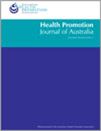Journal list menu
Export Citations
Download PDFs
Editorial – Advancing health promotion through professional development
- Pages: 3-4
- First Published: 01 April 2003
Editorial – The health promotion workforce and workforce development
- Pages: 4-5
- First Published: 01 April 2003
Editorial – Leadership development in health promotion
- Pages: 6-7
- First Published: 01 April 2003
Professional development activities and qualifications of health promotion practitioners in Australia
- Pages: 8-14
- First Published: 01 April 2003
If we are to ensure that the profession has maximum opportunities to expand and disseminate its knowledge base, we need to make use of the potential dissemination tools that are already being accessed by practitioners – such as the journals and newsletters produced by their professional associations.
Variations in perceptions of urban and rural health promotion competencies
- Pages: 15-18
- First Published: 01 April 2003
Workforce development in the areas identified by existing rural health promotion practitioners, a mentor system for new graduates working in rural areas and specific emphasis on these skills in tertiary training for individuals with an interest in rural practice should be considered.
Attitudes and beliefs of oral health professionals regarding their role in health promotion
- Pages: 19-24
- First Published: 01 April 2003
There appears to be a need for public sector oral health services to be reoriented to a primary health care focus. To achieve this, health promotion initiatives must be an integral part of the organisational staffing structure and the practice of each professional.
Perceptions of credentialling for health promotion practitioners in Australia
- Pages: 25-31
- First Published: 01 April 2003
Despite the considerable work already done in identifying and defining competencies required by health promotion practitioners, and the training, development and support mechanisms that might help practitioners to acquire these competencies, there is no mechanism in place in Australia to ascertain the degree to which the competency-based standards in health promotion have actually been achieved or maintained over time. It is recommended that these findings be used in the further research into the possible introduction of credentialling of health promotion practitioners in Australia.
Progressive resistance training for seniors in a community setting – a process evaluation
- Pages: 32-36
- First Published: 01 April 2003
PRT's benefits on the health of older adults indicate that it should be an easily accessible exercise intervention. The process described increased the accessibility and participation of older adults in PRT.
Development of a skin education program for secondary schools
- Pages: 37-41
- First Published: 01 April 2003
Adequate initial consultation with the target group is of paramount importance to enable the most appropriate resources to be developed. This process will increase the likelihood of the appropriateness, uptake and efficacy of materials produced.
Unintended effects of health advertising to women
- Pages: 42-47
- First Published: 01 April 2003
Health promotion professionals need to work closely with media professionals to implement procedures that minimise undesirable, unintended effects of their health advertising.
Laramba Diabetes Project: an evaluation of a participatory project in a remote Northern Territory community
- Pages: 48-53
- First Published: 01 April 2003
The findings of the evaluation indicate a requirement for a more equitable balance in health sector investment between acute and preventive care. Preventive action can be strengthened by addressing processes of local health program priority-setting, the engagement of public health project officers and community-based workers in health promotion partnerships, and a focus on intersectoral collaboration.
Using a participatory action research approach as a process for promoting the health of older people
- Pages: 54-60
- First Published: 01 April 2003
Residents recognised that retirement village life could give them opportunities to take control of their health if five factors were present: the presence of a change agent to establish the empowering processes; attainment of support at a level that assisted daily living but did not detract from autonomy; adequate time frames for change; supportive policies put in place by village management to provide an enabling atmosphere; and enhancement of social connectedness.
A population perspective of osteoporosis. How common? What impact? How modifiable?
- Pages: 61-65
- First Published: 01 April 2003
Perceived risk of getting osteoporosis is generally low. The level of knowledge of the disease and its risk factors was also low. Building ongoing public health awareness campaigns and increased targeting of risk groups for this important chronic condition is warranted.
Using popular children's characters to help parents protect their young children from the sun
- Pages: 66-68
- First Published: 01 April 2003
The paper highlights the opportunity for collaboration with the entertainment sector and shows how popular children's characters can be effectively utilised as role models to promote health behaviour to young children.
Hospital patients receptive to quit smoking advice
- Page: 69
- First Published: 01 April 2003
Letter – Journey to work: the potential for promoting active transport?
- Pages: 70-71
- First Published: 01 April 2003







